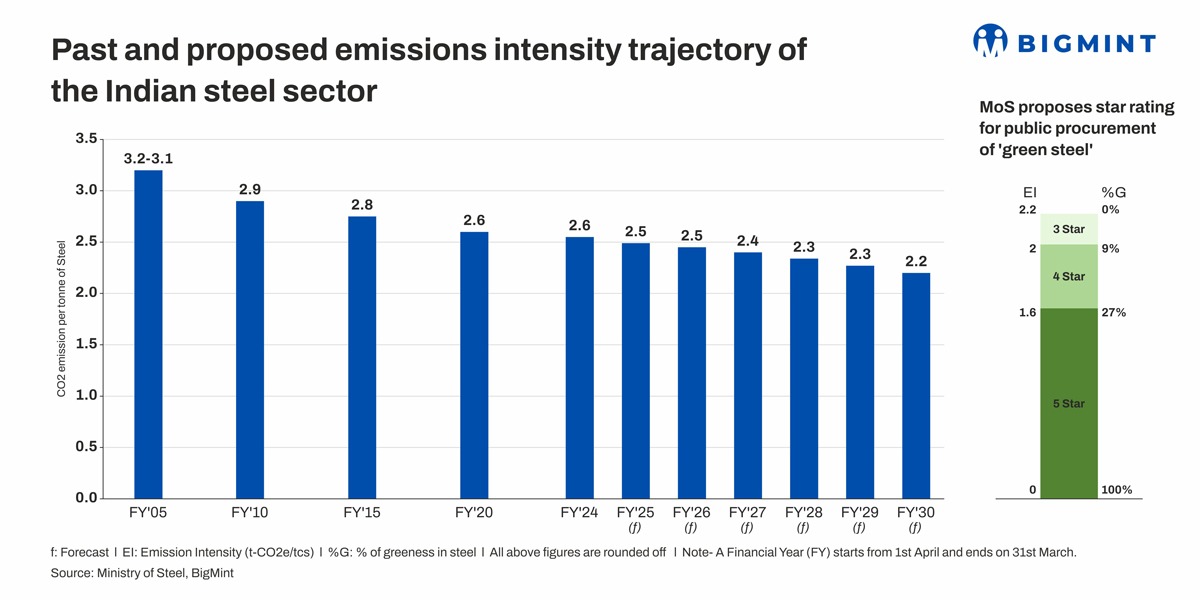India: Govt adopts green steel definition to drive demand generation via sustained policy push
...

- Ministry of Steel (MoS) adopts star-rating system for green steel
- MoS to lay down mandates for green public procurement projects
- Govt mulling directives on green steel use in sustainable energy infra
Morning Brief: India's Ministry of Steel (MoS) has put great emphasis on the exact definition of 'green steel', or low-emissions steel/low CO2-embedded steel, for the purpose of driving the green ecosystem in India. The Ministry is emphasising on an exact definition only to facilitate the green public procurement programme (GPPP) of the government and the emerging carbon credit trading scheme (CCTS).
Taxonomy
As per latest updates from the MoS, 'green steel' is best defined in terms of percentage greenness of the steel produced in a steel plant with CO2 equivalent emission intensity of less than 2.2 tonne of CO2e per tonne of crude steel (tCO2/tcs).
The 'greenness of steel' is expressed as a percentage, based on a steel plant's emission intensity compared to the 2.2 t-CO2e/tcs threshold set up by the MoS.
There is no globally accepted definition of green steel that accommodates multiple factors and constraints arising from the use of varying types of raw materials, fuels and production processes. A taskforce constituted by the MoS for the purpose has assessed various definitions of green steel globally and proposed guiding principles for defining green steel in the Indian context.
Star-rating method
As per latest updates, green-rated steel may be given star rating as-
*3 star: 2.2 to 2.0 t-CO2e/tcs
*4 star: 2.0 to 1.6 t-CO2e/tcs
*5 star: 1.6 to 0.0 t-CO2e/tcs
A green certificate will be issued at the plant level every year and the proposed definition is likely to be revised every three years or so, as and when the need arises.
As a matter of fact, this star rating method was first introduced by the government to channelise energy efficiency measures in different industries which was conceptualised by the Bureau of Energy Efficiency (BEE).
Public procurement policy
Production of green, near-zero or net-zero, steel would entail significantly higher costs because the technologies required to produce such steel are at a low readiness level right now. In addition, the huge coal-based steelmaking fleet in India would require cost-intensive technologies for deep decarbonisation. The premium for green steel over conventionally produced steel is naturally a major deterrent to demand generation.
Therefore, the government's green public procurement programme (GPPP) is vital for demand generation in the early stages. The MoS is working on a broad-based policy of mandating a certain percentage share of green steel procurement for public projects wherein 3 star rated steel will have a share of 20% and 4 star and 5 star rated steel will have shares of 5% and 2%, respectively.
The implementation of this mandate is likely to commence from 2026-27. Notably, unavailability of higher star-rated steel initially will be fulfilled from lower star rated steel. The mandates are to be revised every three years and will be enforced through statutory provisions.
Financing decarbonisation
Sustainable finance would be the key to enabling transition in the steel sector. The MoS has outlined policy prerogatives to finance decarbonisation initiatives in the sector. These are, primarily, green steel purchase mandates and the drive to promote greener production methods through production-linked incentives (PLIs).
Besides public procurement, the need to drive private demand for near-zero steel is critical to boost sectoral transition. In view of this, the MoS is mulling policy instruments such as introducing stickers like 'green steel inside' in products, as well as inclusion of the determined green steel taxonomy in green building codes.
Moreover, the government is also considering mandates for green steel consumption in sustainable technologies like solar panels, wind turbines and electric vehicles.


